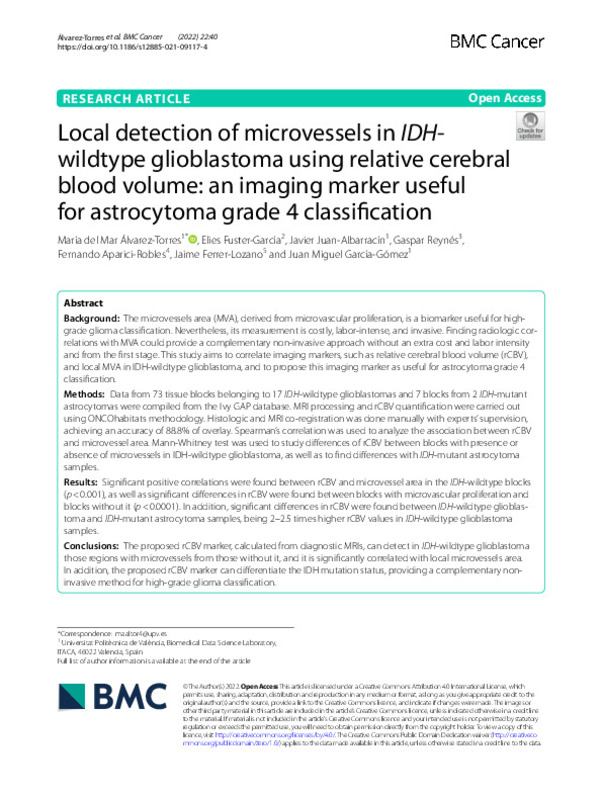Louis N, Perry A, Reifenberge RG, et al. The 2016 World Health Organization classification of tumors of the central nervous system: a summary. Acta Neuropathol. 2016;131:808.
Louis DN, Wesseling P, Aldape K, et al. cIMPACT-NOW update 6: new entity and diagnostic principle recommendations of the cIMPACT-Utrecht meeting on future CNS tumor classification and grading. Brain Pathol. 2020;30(4):844–56.
Das S, Marsden PA. Angiogenesis in Glioblastoma. N Engl J Med. 2013;369(16):1561–3.
[+]
Louis N, Perry A, Reifenberge RG, et al. The 2016 World Health Organization classification of tumors of the central nervous system: a summary. Acta Neuropathol. 2016;131:808.
Louis DN, Wesseling P, Aldape K, et al. cIMPACT-NOW update 6: new entity and diagnostic principle recommendations of the cIMPACT-Utrecht meeting on future CNS tumor classification and grading. Brain Pathol. 2020;30(4):844–56.
Das S, Marsden PA. Angiogenesis in Glioblastoma. N Engl J Med. 2013;369(16):1561–3.
Weis SM, Cheresh DA. Tumor angiogenesis: molecular pathways and therapeutic targets. Nat Med. 2011;17:1359–65.
De Palma M, Biziato D, Petrova TV, et al. Microenviromental regulation of tumour angiogenesis. Nat Rev Cancer. 2017;17:13.
Wu H, Tong H, Du X, et al. Vascular habitat analysis based on dynamic susceptibility contrast perfusion MRI predicts IDH mutation status and prognosis in high-grade gliomas. Eur Radiol. 2020;30(6):3254–65.
Ziyad S, Iruela-Arispe ML. Molecular mechanisms of tumor angiogenesis. Genes Cancer. 2011;2(12):1085–96.
Ling C, Pouget C, Rech F, et al. Endothelial cell hypertrophy and microvascular proliferation in Meningiomas are correlated with higher histological grade and shorter progression-free survival. J Neuropathol Exp Neurol. 2016;75(12):1160–70.
Hu LS, Eschbacher JM, Dueck AC, et al. Correlations between perfusion MR imaging cerebral blood volume, microvessel quantification, and clinical outcome using stereotactic analysis in recurrent high-grade glioma. J Neuradiol. 2012;33:69–76.
Sharma S, Sharma MC, Sarkar C, et al. Morphology of angiogenesis in human cancer: a conceptual overview, histoprognostic perspective and significance of neoangiogenesis. Histopathology. 2005;46:481–9.
Pathak AP, Schmainda KM, Douglas B, et al. MR-derived cerebral blood volume maps: issues regarding histological validation and assessment of tumor angiogenesis. Magn Reson Med. 2001;46:735–47.
Hu LS, Haawkins-Daarud A, Wang L, et al. Imaging of intratumoral heterogeneity in high-grade glioma. Cancer Lett. 2020;477:97–103.
Cha S, Johnson G, Wadghiri YZ, et al. Dynamic, contrast-enhanced perfusion MRI in mouse gliomas: correlation with histopathology. Magn Reson Med. 2003;49:848–55.
Chakhoyan A, Yao J, Leu K, et al. Validation of vessel size imaging (VSI) in high-grade human gliomas using magnetic resonance imaging, imageguided biopsies, and quantitative immunohistochemistry. Sci Rep. 2019;9:2846.
Sadegui N, D’Haene N, Decaestecker C, et al. Apparent diffusion coefficient and cerebral blood volume in brain gliomas: relation to tumor cell density and tumor microvessel density based on stereotactic biopsies. Am J Neuroradiol. 2008;29:476–82.
Sugahara T, Kiorogi Y, Kochi M, et al. Correlation of MR imaging determined cerebral blood volume maps with histologic and angiographic determination of vascularity of gliomas. Am J Neuroradiol. 1998;171:1479–86.
Birner P, Piribauer M, Fischer I, et al. Vascular patterns in glioblastoma influence clinical outcome and associate with variable expression of angiogenic proteins: evidence for distinct angiogenic subtypes. Brain Pathol. 2003;13:133–43.
Folkerth RD. Histologic measures of angiogenesis in human primary brain tumors. Cancer Treat Res. 2004;117:79–95.
Donahue KM, Krouwer HGJ, Rand SD, et al. Utility of simultaneously-acquired gradient-echo and spin-echo cerebral blood volume and morphology maps in brain tumor patients. Magn Reson Med. 2000;43:845–53.
Aronen HJ, Gazit IE, Louis DN, et al. Cerebral blood volume maps of gliomas: comparison with tumor grade and histological findings. Radiology. 1994;191:41–51.
Li X, Tang Q, Yu J, et al. Microvascularity detection and quantification in glioma: a noveldeep-learning-based framework. Lab Investig. 2019;99(10):1515–26. https://doi.org/10.1038/s41374-019-0272-3.
Álvarez-Torres M, Juan-Albarracín J, Fuster-Garcia E, et al. Robust association between vascular habitats and patient prognosis in glioblastoma: an international multicenter study. J Magn Reson Imaging. 2020;51(5):1478–86.
Juan-Albarracín J, Fuster-García E, Pérez-Girbés, et al. Glioblastoma: vascular habitats detected at preoperative dynamic susceptibilityweighted contrast-enhanced perfusion MR imaging predict survival. Radiology. 2018;287:944–54.
Juan-Albarracín J, Fuster-García E, García-Ferrando GA, et al. ONCOhabitats: a system for glioblastoma heterogeneity assessment through MRI. Int J Med Inform. 2019;128:53–61.
Weibel ER. Estimation of basic Stereologic parameters: theoretical foundations of stereology. Academic Press, vol. 2; 1980.
Essig M, Shiroishi MS, Nguyen TB, et al. Perfusion MRI: the five Most frequently asked technical questions. AJR Am J Roentgenol. 2013;200(1):24–34.
Puchalski RB, Shah N, Miller J, et al. An anatomic transcriptional atlas of human glioblastoma. Science. 2018;360:660–3.
Boxerman JL, Schmainda KM, Weisskoff RM, et al. Relative cerebral blood volume maps corrected for contrast agent extravasation significantly correlate with glioma tumor grade, whereas uncorrected maps do not. Am J Neuroradiol. 2006;27(4):859–67.
Álvarez-Torres M, Fuster-García E, Reynes G, et al. Differential effect of vascularity between long- and short-term survivors with IDH1/2 wild-type glioblastoma. NMR Biomed. 2021;34(4):e4462.
Fuster-Garcia E, Lorente ED, Álvarez-Torres M, et al. MGMT methylation may benefit overall survival in patients with moderately vascularized glioblastomas. Eur Radiol. 2021;31:1738–47.
Álvarez-Torres M, Chelebian E, Fuster-García E, et al. ONCOhabitats results for ivy glioblastoma atlas project (ivy gap): segmentation and hemodynamic tissue signature (version 1.0) [data set]. Zenodo; 2021. https://doi.org/10.5281/zenodo.4704106.
[-]









